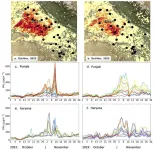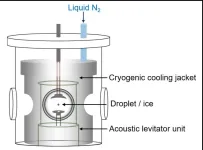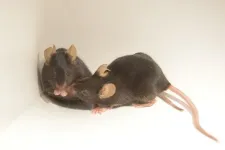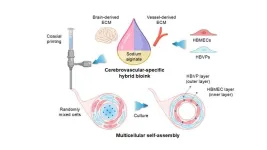(Press-News.org) SPOKANE, Wash. — Washington State University scientists have created genetically-engineered mice that could help accelerate anti-aging research.
Globally, scientists are working to unlock the secrets of extending human lifespan at the cellular level, where aging occurs gradually due to the shortening of telomeres–the protective caps at the ends of chromosomes that function like shoelace tips to prevent unraveling. As telomeres shorten over time, cells lose their ability to divide for healthy growth, and some eventually begin to die.
But research studying these telomeres at the cellular level has been challenging in humans.
Now, a discovery by a WSU research team published today in the journal Nature Communications has opened the door to using the genetically engineered mice.
Led by WSU College of Pharmacy and Pharmaceutical Sciences Professor Jiyue Zhu, the research team has developed mice that have human-like short telomeres, enabling the study of cellular aging as it occurs in the human body and within organs. Normally mice have telomeres that are up to 10 times longer than humans.
“This is the first mouse model with truly humanized telomeres because telomerase isn’t expressed in adult tissues in this model,” Zhu said. “Our paper demonstrates that they exhibit human-like telomeres. Now, we aim to observe how these mice age.”
Called HuT mice for their humanized telomeres, they are enabling Zhu’s team to advance multiple research projects. Key areas of focus include studying how short telomeres reduce the likelihood of developing cancer and influence human lifespan, as well as exploring strategies to extend individuals’ health span– the period of life free from age-related diseases.
The work has significant implications for the development of future drugs and treatments. In the long term it may pave the way for anti-aging strategies aimed to activating cells to protect telomeres, and potentially extend lifespans. Zhu noted that many diseases originate at the cellular level, so targeting drugs there is a common strategy.
Telomerase levels are crucial because cancer cells divide rapidly and need high amounts of telomerase to maintain their telomeres. “One of our goals is to reduce telomerase expression in cancer cells, and this is an active area of research.”
The mouse model allows for multiple aging studies, Zhu said. One of his collaborators, WSU Elson S. Floyd College of Medicine researcher Christopher Davis, studies how sleep impacts human health. The group will use HuT mice to see how the stress of sleep deprivation and other life stresses affect telomere regulation and aging.
Zhu began telomere studies in the mid-1990s under researchers and Nobel Prize winners Elizabeth Blackburn and J. Michael Bishop, both pioneers in understanding telomeres and cancer. Zhu joined WSU in 2014.
The development of HuT mice began 10 years ago, when he and other researchers gained a deeper understanding of telomere regulation in humans and how it differs from animals. Previously, how telomeres regulated the human aging process could only be studied using isolated human cells in a petri dish. “This mouse model is quite different, as it allows us to observe the aging process in a whole organism,” Zhu said. “Mice are similar to humans in terms of organ structure, genes, and genetic makeup.”
Zhu said the WSU team hopes to eventually share the mice with other research teams to help advance studies on aging, human longevity, and cancer. “There are thousands of people studying aging and cancer, and we believe the new mouse model provides a valuable tool for scientists worldwide to explore these processes.”
Zhu received $5 million in grants for studies to further develop the mouse model that simulates human replicative aging as well as to research cancer implications. The funding includes grants from the National Institute on Aging, National Institute of General Medical Sciences and the U.S. Department of Defense, with the latter to study how telomere length affects melanoma cancer cells.
END
WSU researcher pioneers new study model with clues to anti-aging
2025-02-04
ELSE PRESS RELEASES FROM THIS DATE:
EU awards €5 grant to 18 international researchers in critical raw materials, the “21st century's gold”
2025-02-04
The new EU-funded consortium “ForMovFluid” will study how fluids transformed the materials inside the Earth's crust. Thanks to the Marie Skłodowska-Curie Action Doctoral Networks programme, ForMovFluid will fund the doctoral studies of 18 researchers, and train them to become elite experts in the field of geoscience.
Moreover, this project will allow us to understand the origin of the so-called critical raw materials, of vital importance for the energy transition. Over a period of four years, ForMovFluid “Marie Curie” researchers ...
FRONTIERS launches dedicated call for early-career science journalists
2025-02-04
FRONTIERS announces a new call for applications for its Science Journalism in Residency Programme, funded by the European Research Council (ERC). This
third call is exclusively aimed at early-career journalists and will remain open until May 6, 2025, at 17h00 CEST.
Science journalists with up to five years of experience are invited to apply for a residency at a research institution of their choice, in an EU Member State or a
country associated with the EU’s Horizon Europe Programme. The residencies, lasting between three to five months, should focus on frontier science topics, in
collaboration with scientists.
The ...
Why do plants transport energy so efficiently and quickly?
2025-02-04
The efficient conversion of solar energy into storable forms of chemical energy is the dream of many engineers. Nature found a perfect solution to this problem billions of years ago. The new study shows that quantum mechanics is not just for physicists but also plays a key role in biology.
Photosynthetic organisms such as green plants use quantum mechanical processes to harness the energy of the sun, as Prof. Jürgen Hauer explains: “When light is absorbed in a leaf, for example, the electronic excitation energy is distributed over several states ...
AI boosts employee work experiences
2025-02-04
A new paper in the Quarterly Journal of Economics, published by Oxford University Press, shows customer service workers using artificial intelligence assistance become more productive and work faster. The effects vary significantly, however. Less experienced and lower-skilled employees improve both the speed and quality of their work, while the most experienced and highest-skilled workers see small gains in speed and small declines in quality. The researchers also found that AI assistance can help worker learning and improve English fluency, particularly for international workers.
Computers and software have transformed the economy with their ability to perform certain tasks with far ...
Neurogenetics leader decodes trauma's imprint on the brain through groundbreaking PTSD research
2025-02-04
BELMONT, Massachusetts, USA, 4 February 2025 - In a comprehensive Genomic Press Interview, Dr. Kerry Ressler, Chief Scientific Officer at McLean Hospital and Professor of Psychiatry at Harvard Medical School, unveils groundbreaking advances in understanding the neurobiological basis of post-traumatic stress disorder (PTSD) and related anxiety conditions.
Dr. Ressler's research bridges the gap between molecular neuroscience and clinical psychiatry, focusing on how the amygdala processes fear and trauma at cellular and genomic levels. "Most proximally, I hope that our work may lead to novel approaches to fear- and trauma-related disorders, perhaps even to prevent ...
High PM2.5 levels in Delhi-NCR largely independent of Punjab-Haryana crop fires
2025-02-04
International collaborative research led by Aakash Project* researchers at the Research Institute for Humanity and Nature (RIHN) show an unequivocal contribution of crop residue burning (CRB) to air pollution in the rural/semi-urban regions of Punjab and Haryana, and a relatively lower contribution than previously thought to the Delhi national capital region (NCR). We have installed 30 units of compact and useful PM2.5** in situ instrument with gas sensors (CUPI-Gs) and have continuously recorded air pollutants in 2022 and 2023. New analytical methods have been developed to assess ...
Discovery of water droplet freezing steps bridges atmospheric science, climate solutions
2025-02-04
A groundbreaking University of Hawaiʻi at Mānoa study on the freezing of water droplets suspended in air sheds light on a key process in Earth’s water cycle: the transformation of supercooled water into ice.
Conducted using a novel cryogenically cooled ultrasonic levitation chamber, the research captures real-time molecular-level changes during the freezing process, mimicking conditions in the Earth’s atmosphere. This innovative setup enables researchers to observe how water droplets transition to ice at subzero temperatures, providing ...
Positive emotions plus deep sleep equals longer-lasting perceptual memories
2025-02-04
Researchers at the RIKEN Center for Brain Science (CBS) have uncovered how perceptual memories linked to positive emotions, such as joy or happiness, are strengthened during sleep. The study, published in the scientific journal Neuron, could help scientists understand the neurological basis for overcoming conditions like drug or sexual addiction.
Why do emotional events, whether positive or negative, create strong, long-lasting memories of external information such as music, scene smells and textures received at the events? We know that sleep is essential for memory consolidation, the process that turns new events into memories, but do not ...
Self-assembling cerebral blood vessels: A breakthrough in Alzheimer’s treatment
2025-02-04
A 3D model accurately mimicking the Blood-Brain Barrier (BBB) in a laboratory environment has been successfully developed by research teams led by Professor Jinah Jang from the Departments of Mechanical Engineering, Life Sciences, IT Convergence Engineering, and the Graduate School of Convergence at POSTECH, and Professor Sun Ha Paek from the Department of Neurosurgery at Seoul National University Hospital. This study was recently published in Biomaterials Research, an international academic journal on materials science.
Neurodegenerative diseases, ...
Adverse childhood experiences in firstborns associated with poor mental health of siblings
2025-02-04
Children are nearly three-quarters (71%) more likely to develop mental health problems between the ages of five and 18, if the firstborn child in their family experienced adversity during their first 1,000 days, finds a new study led by UCL researchers.
The first-of-its-kind study, published in The Lancet Public Health and funded by the National Institute for Health and Care Research Policy Research Programme, found that mothers whose firstborns had experienced adverse childhood experiences had a 71% increased risk of having children (aged five -18) with mental health problems, compared to mothers whose firstborn did not experience adversity.
This ...





